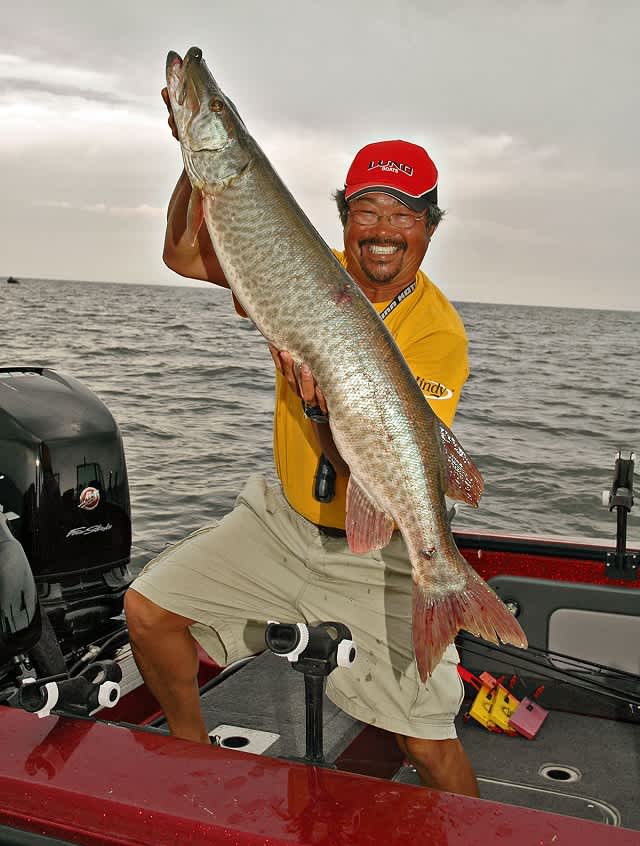Ted Takasaki’s Summertime Muskie Fishing Tips and Tricks
Ted Takasaki 08.29.12

It’s just fine with muskie expert Trent Lehner that many anglers chasing big fish concentrate on big waters like Mille Lacs, Lake Vermillion, or Leech Lake. Certainly, Mille Lacs and Vermillion have been giving up monster muskies for years. Still, ask Lehner where he likes to fish and he’ll rattle off names like Little Boy, Wabedo and Mantrap. Those are the kinds of smaller, lesser-known, less-pressured waters he likes to focus on, and he gives nothing up in the size department when he does.
Over the July 4th weekend a few years ago, Lehner boated a 55-inch fish from a 1,400-acre lake about an hour north of Brainerd. He’d been chasing that fish for four years.
It was his second 55-inch muskie in a year.
“Those fish (in smaller lakes) are a little bit smarter,” says Lehner, “but if you keep reading about muskie fishing, learn new things, it pays off in the long run if you put in the effort. I’m having my best year yet by staying on small lakes.”
Convincing people to share the names of small lakes that produce big muskies isn’t easy. Nor should it be. Trophy muskies are a fragile resource that must be protected. But Lehner gives us a hint. The process, for him, starts by paying attention to postings on the Internet, reading muskie magazines, map books, and Department of Natural Resources profiles of every lake he can. He mainly focuses on the results of fishing surveys.
“How many fish were caught in the DNR survey nets?” he asks. “If it has great numbers, you’ll catch lots of fish, and eventually you’ll catch a big fish.”
Next, Lehner targets the lakes at peak times, like full and new moon phases. That’s when the big fish are more likely to give away their location. He’ll return at off-peak times, too, to see if the muskie will follow his lure and confirm that’s where she lives.
Knowing her address is at least half the challenge.
“If you raise it,” says Lehner, “then you know that fish is a home body.”
The specific areas where Lehner targets his efforts will depend upon the habitat of the lake. The choice boils down to weeds or rocks. With weeds, it’s a matter of identifying edges and casting parallel along them. A GPS helps by drawing the outline of the breakline (dropoff) on the screen. By looking at the display, you can see points and inside turns that hold fish. Look for places where two kinds of weeds meet, signaling a change in bottom content that can enrich the food chain at that point.
If big muskies still play hide and seek, Lehner moves inside the edges and fishes over the top edge of the weeds. Again, he looks for places where a different type of weed may rise higher in the water column than the surrounding bed.
Here’s another key to watch for: muskies in weeds will sometimes be very aggressive in eating a lure. But sometimes they’ll just swim after it and close their mouth over it. To an angler on the other end, the sensation can feel like nothing more than when a lure gets fouled in a weed.
“Set the hook on everything,” advises Lehner.
With rocks, it’s not enough just to have gravel. Lehner looks for places that feature boulders where muskies hide in between the cracks that separate them to ambush prey. He casts so his lure finds the crack, he lets it fall and then he reels it right back over any waiting fish’s head.
“They are just waiting,” he says, “for something to pass by.”
He likes to keep the boat in about 13 to 15 feet of water and cast to about 7 feet. When he feels his lure contacted a rock, out comes the hook sharpening file. Hunting muskies over 50 inches is no time to lose a fish from a dull hook.
Lehner starts the year using smaller bucktails, but quickly moves to larger bucktails and spinnerbaits like the M&G. Rad dogs go deep. M&Gs are for shallower areas, he said.
Bulldogs are a terrific go-to bait when nothing else seems to work, he said. Let them fall to the weed tops and jerk them back to the boat. “They can’t resist it,” Lehner said.
He tries to gauge the mood of a big fish that follows. Slow, lethargic fish are left alone for another day or a time when conditions improve, such as the approach of a rainstorm or a change in wind direction and strength. Some people swear by low-light conditions, but Lehner isn’t one of them. His 55-inch fish have come in bright sunlight.
One final tip that can help turn followers into biters. When a “hot” fish turns off his jerkbait, Lehner tosses back an M&G. “They’ll just crush it,” he said.
Note: Takasaki is teaming up with Anderson Trucking Service to offer fishing tips to the company’s drivers, along with the chance to win all-expenses-paid fishing trips with the Hall of Fame angler. Ted’s Tips are found at www.drive4ats.com, along with information on joining this industry leader, founded in 1955. Interested drivers can also call 1-855-JOIN-ATS.

